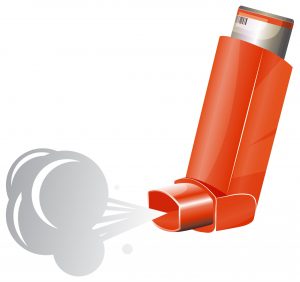Asthma article 5: Make sure you’re not running on empty!
How do you know when asthma inhalers are empty? Some inhalers contain a propellant gas to deliver the asthma medicine into the lungs in a fine mist. However these inhalers can run out of medicine before the gas runs out. The inhaler will still look and sound like it is working, but you cannot tell if contains medicine or is just the delivery gas. As it is so difficult to tell whether an inhaler is empty, it is important to keep track of how much of the medicine your child uses, so that there is no risk of them running out.
Many medicines for asthma come in a pressurised metered dose inhaler (pMDI) which include a harmless propellant gas to deliver the medicine into the airways. However, cannisters contain extra propellant gas. This means that a cannister can run out of medicine, but it will still release a spray of gas. You may see a cloud of gas if you squirt the inhaler into the air, and it may sound like the canister has something in it if you shake it. But, importantly you cannot tell if this is gas or medicine. Also, you cannot taste the difference between gas and medicine. Some websites suggest that you can tell how full a cannister is by floating it in water; however, this is not a reliable test and is not recommended.

Because it is so difficult to tell when a cannister is empty, it is important to keep track of how much of the medicine your child uses, so that there is no risk of them running out. Keeping track is quite easy with the preventer medicines that are used every day, but is a little harder for reliever medicines that are used only when needed. Some newer inhalers have a dose counter but it is important to check this regularly – people often forget. Recent research has found that these dose counters can be inaccurate.
How to keep track of preventer medicines
- Work out the number of doses your child has each day – this is the number of times a day they use it (once or twice) multiplied by the number of doses (puffs) each time. For example, if your child has two puffs each morning and two each evening, this is four doses each day.
- Find out the number of doses in the inhaler – this information will be on the packaging and you can ask your pharmacist for help finding this information.
- Divide the number of doses in the inhaler by the number of doses your child has each day. This will tell you how many days it will last. For example, if the inhaler contains 200 doses and your child has 4 doses each day, the inhaler will last 50 days (200 ÷ 4 = 50), which is 7 weeks. If your child has 2 doses per day, the inhaler will last 100 days (200 ÷ 2 = 100), which is just over 3 months.
- The table below shows the calculation described.
- You can complete your own version of the table below by clicking on the table or by following the link: Medicines for Children inhaler usage calculator
- This will take you to our inhaler usage calculator. The team at Medicines for Children have developed this to help you work out when your child’s inhaler will run out of medicine.
- On the calculator, you can enter your child’s specific information and the calculator will estimate when the inhaler will run out.
- Write on the inhaler when it is expected to run out. Your child should start a new inhaler then, even if you think there might be some medicine left in it. Make sure you order a replacement inhaler in advance of this date.
How to keep track of reliever medicines
Reliever inhalers are only used when needed – i.e. your child does not take a set amount of puffs every day. Therefore it is harder to keep track of how much medicine is left in the inhaler. You or your child could use your mobile phone or a notebook to keep count, or you might stick a label on the cannister and keep a tally of when you use it. If your child has several reliever inhalers, it is important to keep track of each one separately. You might, for example, put coloured stickers on them so you can keep track of which inhaler is used.
What to do with old inhalers
Please always take old inhalers to your pharmacy – do not put them in the household rubbish or recycling bin. The propellant gas used in some inhalers contributes to greenhouse gases. Whilst the propellant will not harm your child, it is important to limit the amount released into the air.
Thank you…
Many thanks to the members of the West Midlands Paediatric severe Asthma Network and the asthma team at Birmingham Children’s Hospital for their work in this area. We would specifically like to thank Prasad Nagakumar, Sue Frost and Satish Rao who led a project in the West Midlands with families into identifying when an inhaler is empty. Their work inspired this series of information articles on asthma and inhalers.

